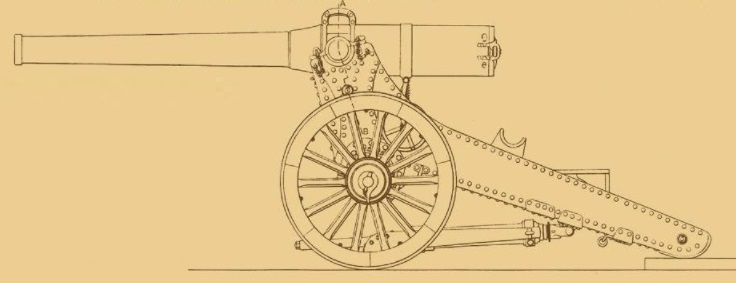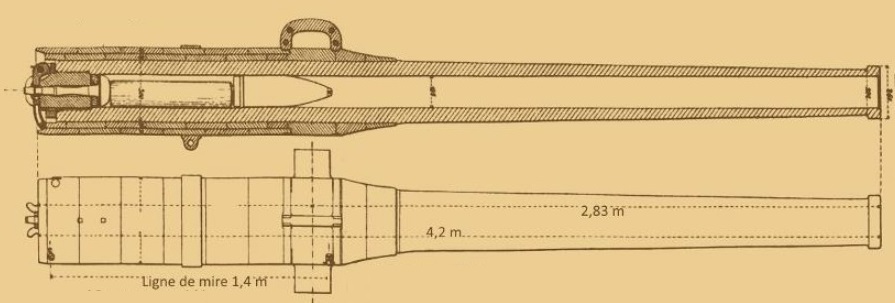Following their defeat in the Franco-Prussian War 1870-71, France set up an artillery committee in 1874 to consider new designs for both siege and fortress guns including the choice of calibres. The committee concluded that a calibre of 155 mm was required for the siege guns and 120 mm was required for the fortress guns. Three different prototypes were tested in 1876 for the 155 mm siege gun with the design from Charles de Bange finally being selected and then put into production in 1877 as the Canon de 155 L 1877 de Bange with the ‘L’ standing for longue or long.
However, by the turn of the century, the Mle 1877 was considered obsolete and was therefore transferred to fortresses and to the reserve. In fact, in 1904, Colonel Emile Rimailho who had helped develop the Canon de 75 Mle 1897 while working at the War Ministry’s artillery workshop at Puteaux, designed a short, quick firing 155 mm howitzer to complement the Mle 1897. This was adopted by the French Army in 1907 as the Canon de 155 Mle 1904 CTR Rimailho.
However, the French doctrine before WW1 was to rely mainly on the fast firing Mle 1897 and so only 104 Mle 1904 guns were available at the outbreak of war. At that point, in order to provide more 155 mm howitzers for the Army, the Mle 1877 was brought of retirement since there was well over a thousand available. It performed well during the early part of WW1 despite its slow rate of fire because it provided a maximum range considerably longer than that provided by the Mle 1904. It was then not until 1916 that more modern 155 mm howitzers began to replace it starting with the conversion of small numbers of the Mle 1877 with a more modern carriage as the Canon de 155 L Mle 1877/14 Schneider .

Carriage
The Mle 1877 was designed 20 years before the first effective recoil system was developed and therefore used a simple carriage with box trail. It was originally designed to be mounted on a wooden platform which made it easier to push back into position after it recoiled. Later, the Mle 1883 St. Chamond hydraulic brake was introduced connecting the trail to the platform providing 110 cm of recoil before returning the gun back to its firing position.

No traverse was provided for the gun on the carriage with the trail having to be moved sideways to provide this using wooden poles for leverage. The gun was elevated on trunnions at the front top of the carriage via an elevating arc attached to the band clearly visible around the rear of the gun. Elevating hand wheels were provided on either side of the carriage which engaged with the elevating arc via a pinion.

The gun was originally transported using a team of 8 horses. In order to do this, a second pair of wheels was attached to the rear of the trail and, using an A-frame, the gun was then lifted off its trunnion bearings and moved backwards on to its rear trunnion mounts halfway along the trail. This was done to even the weight distribution between the two sets of wheels.

Gun Design
The gun was 27 calibres in length and originally of steel hooped construction where hoops were shrunk on to the rear of the rifled tube in order to provide the necessary strength. A riveted longitudinal loop was added at the centre of gravity on top of the gun for lifting purposes. These gun had a progressive form of rifling. As the original barrels wore out, after 1916 the design was changed to incorporate a jacket shrunk on to the rifled barrel and these can be distinguished by the transverse lifting handle. These guns were manufactured with a constant rifling twist.

The Mle 1877 used bagged propellants containing gunpowder pads in the base which were ignited by the flash from a friction tube inserted into the rear of the breech that was operated via a lanyard. The problem of sealing the breech was solved by de Bange using an interrupted threaded breech screw with a mushroom shaped obturator projecting from the front of it with a fire proof seal behind the head. When the propellant ignited, the combustion chamber pressure forced the obturator backwards slightly, compressing the seal and forcing it outwards against the rear of the chamber thereby sealing it. The de Bange breech design, in fact, formed the basis for most breech designs that followed using bagged propellants.
The breech was unlocked by pulling up on the central lever and then rotating the breech plug by 45 degrees after which it could be pulled backwards relative to the hinged bracket and then swung out of the way to expose the breech. The breech plug contained a central vent through which the flash from a friction cartridge set off the bagged cartridge.
 Sights
Sights
At the time that the Mle 1877 entered service, artillery was only effectively used in the direct fire mode where the target could be seen in the sights. Originally, the Mle 1877 was fitted with what the British would call cross-bar sights which can be seen in the above picture of the breech mechanism. The height of the cross-bar sight was adjusted to set up the quadrant elevation of the gun required to hit a target at a particular range. The cross-bar itself allowed the sight to be adjusted for deflection. The sights were of robust construction in order to survive the shock of firing.
The Boers used a version of the Mle 1877 during the 2nd Boer War (1899-02) which the British called a ‘Long Tom’. Both sides recognised the advantage of indirect fire since it allowed their artillery to remain unseen by the enemy but the means for achieving this was very rudimentary at the time. However, by the start of WW1, most nations had developed panoramic telescopes or dial sights to facilitate indirect fire. In the case of the Mle 1877, a dial sight was used similar to that on the Mle 1897 consisting of a collimator on a pillar fixed to a rotatable base graduated in milliemes.
With the gun at zero elevation, the dial sight was slotted into the top of the gun behind the trunnions. In indirect fire, the target direction is specified as an offset angle to an aiming point set up for the gun which could be a prominent feature on the landscape but had to be visible in the dial sight. By setting the offset target direction on the sight, all the gun layer then had to do was to traverse the gun until the aiming point was aligned in the dial sight. Once this was done, it meant that the gun was then aligned with the target.
In order to set the elevation of the gun in indirect mode, a clinometer was attached to the right-hand gun trunnion which was then set up for the quadrant elevation needed to hit a target at a particular range. The gun was then elevated until the clinometer bubble was zeroed.
Before the gun was fired, both the dial sight and the clinometer had to be removed in order to prevent damage due to shock.
Ammunition
The Mle 1877 fired shells weighing approximately 43 kg using a fixed charge originally giving a muzzle velocity of 470 m/s and a maximum range of 9,800 m.
However, in 1915, with an increase in propellant charge and a more streamline shape for the Fonte Acieree (FA) shell, this increased the muzzle velocity to 561 m/s and the maximum range to 12,700 m.
The Mle fired both Shrapnel (2 x shells on left below) and high explosive (2 x shells on right below) with the 1915 shells being made from cast iron (fonte acieree) rather than steel (acier).

A wide range of fuzes were used with the shells ranging from super quick percussion to dual effect time and percussion.

Canon de 155 Mle 1877 Specifications
- Length: 6.1 m
- Maximum Width: 2.03 m
- Wheels: Wooden 1.53 m in diameter
- Weight of Gun & Carriage: 5806 kg
- Length of Gun: 4.185 m or 27 calibres
- Bore: 15.5 cm
- Muzzle Velocity: 561 m/s (1915 FA shell)
- Maximum Range: 12,700 m (1915 FA shell)
- Trail: Box trail
- Recoil System: None
- Rifling: Progressive 1 turn in 25 calibres to 1 turn in 13.6 calibres
- Length of Rifling: 3.10 mm or 20 calibres
- Twist: Left-hand
- Grooves: 48
- Firing Method: Friction tube
- Elevation: -12° to +28°
- Traverse: None
![]()

